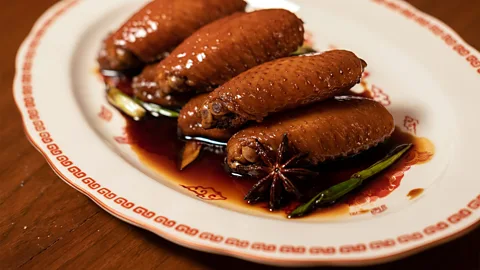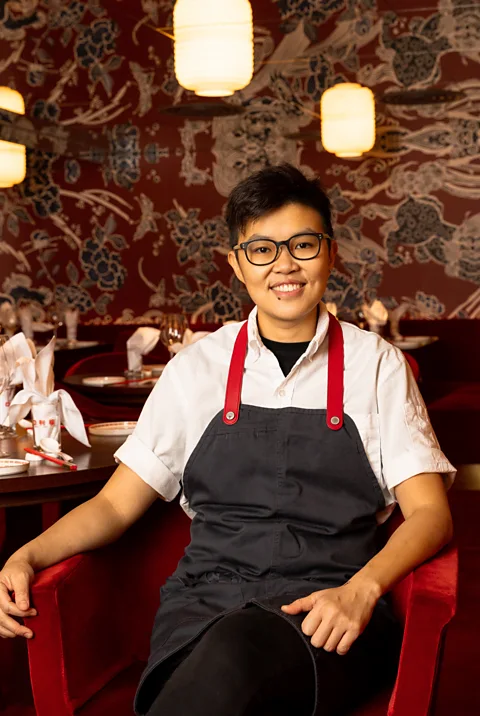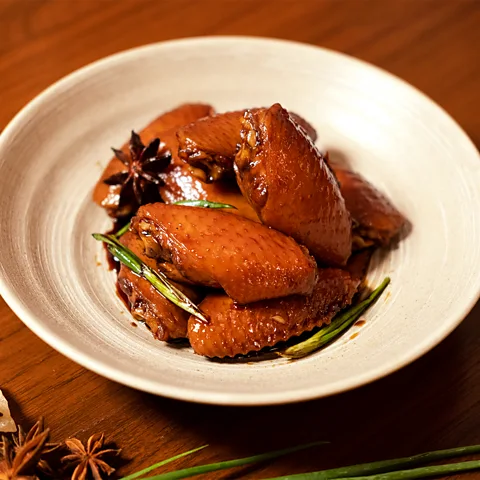ArChan Chan's Sweet-soy chicken wings from Hong Kong
 Black Sheep Staff
Black Sheep StaffHong Kong's popular Swiss wings are glossy, sticky and sweet. But don't be fooled by the name: these wings are not remotely related to Switzerland.
In Hong Kong, there is no shortage of good chicken wing spots, from Taiwanese fried wings at snack stands and Korean fried chicken ts to all-you-can-eat Buffalo wings at American restaurants.
Out of all the options, however, Swiss chicken wings are one of the most popular choices, available at cha chaan tengs – Hong Kong's version of cafes or diners.
Swiss chicken wings are usually poached in water then cooked in soy sauce, sugar and spices until the wings have turned a reddish hue. When done cooking, the juicy wings are coated in a glossy, caramelised sweet-soy sauce.
But don't let the name of the chicken dish fool you, these wings are not remotely related to Switzerland, nor did the Swiss influence the recipe in the slightest.
"While no one is quite certain where Swiss chicken wings originated, rumour is that it was a classic case of translation gone wrong," said ArChan Chan, executive chef of Ho Lee Fook, a creative Chinese restaurant in Hong Kong. She is also the author of Hong Kong Local: Cult Recipes from the Streets that Make the City.
The story of how the dish gained its name varies slightly. Some say a Westerner tried the dish and exclaimed at its sweetness to the waiter, but the word "sweet" was misinterpreted as "Swiss" due to the language barrier. The waiter then assumed that the chef had made an Alpine speciality and went on to call them Swiss wings. In another version of the story, the tourist asked the waiter what the dish was, and the waiter answered, "sweet wing". The Westerner misheard it as "Swiss wing", and the name stuck.
 Black Sheep Staff
Black Sheep StaffDespite the name's foggy origins, it's believed that the dish was invented in 1860 by Chui Lo Ko, the founder of Tai Ping Koon Restaurant. At the time, the restaurant was considered a high-end establishment, and stood out as the first Cantonese Western restaurant in Guangzhou, China. In 1938, the Chui family brought Tai Ping Koon to Hong Kong and opened a branch in the neighbourhood of Sheung Wan. Today, Tai Ping Koon remains in the Chui family, with several locations in Hong Kong. Swiss chicken wings are still ordered by nearly every table.
Cantonese Western food, also known as "soy sauce Western", is a type of Hong Kong cuisine in which Western dishes – such as steak, pasta and salad – were adapted to the local palate. It was popularised in the 1960s and '70s during British rule, when restaurants wanted to appeal to both locals and Brits. Steaks were served on a sizzling hot iron plate, for example, accompanied by a jug of soy-sauce infused peppercorn or onion gravy. In place of mashed potatoes, diners could opt for a bowl of white rice instead.
As a colony, then a dependent territory of the British Empire from 1841 to 1997, there's no denying that Hong Kong has incorporated traits of British cooking over the years. "Hong Kong has a strong British influence," said Chan. "For instance, we often drink milk with our tea, a derivation of English tea with milk – except we use evaporated or condensed milk [as a substitute]."
"You will see a lot of Western influence just because of the way history panned out. From [Hong Kong-style] French toast and macaroni soup for breakfast to steak served with black pepper sauce and borscht," she added.
For those of us who love a good backstory and sweet wings, however, Swiss chicken wings are the obvious favourite.
 Black Sheep Staff
Black Sheep StaffServes 3 to 4
Ingredients
For the chicken wings:
2 tbsp fine sea salt
1kg (about 2lb) chicken wings, well washed
For the vegetable stock:
250ml (1 cup) rapeseed, vegetable or canola oil
10 shallots, peeled
100g (3½oz) sliced ginger
5 spring onions (scallions), sliced into batons
½ carrot, roughly chopped
1 onion, roughly chopped
1 celery stalk, roughly chopped
1kg (about 2lb) chicken bones for a more intense flavour (optional)
125ml (½ cup) Shaoxing wine
For the soy sauce stock:
500ml (2 cups) light soy sauce
150ml (⅔ cup) dark soy sauce
300g (⅔ lb) yellow rock sugar, cane sugar, coconut sugar or brown sugar
5 cloves
2 star anise
2 bay leaves
Method
Step 1
In a large bowl, dissolve the salt in 2 litres of water. Add the chicken and leave to soak for an hour. Drain and pat the chicken wings dry with paper towels. Clean the bowl.
Step 2
Bring 2 litres of water to a boil in a wok or large saucepan. Separately, refill the cleaned bowl with 2 litres of ice water. Put all the chicken wings in the boiling water for 1 minute, then transfer them straight to the ice water and let sit to tighten the skin.
Step 3
To make the vegetable stock, in a wok or large saucepan, heat the 1 cup of oil to 160C/320F. Lightly fry all the vegetables until golden brown, then use a slotted spoon to transfer the vegetables to a plate. If you are using chicken bones, give them a quick stir-fry until golden.
Step 4
Add the vegetables back to the wok (with the bones, if using) over medium heat. Add the Shaoxing wine and 2 litres of water and simmer for 30 minutes until there is about 1 litre of liquid left.
Step 5
Add all the soy sauce stock ingredients and bring to a boil, stirring occasionally, until the sugar has dissolved. Reduce the heat to medium.
Step 6
Drain the chicken wings and pat dry. Add the wings to the wok and bring to a simmer, then turn the heat to low and let poach for 15 minutes. Turn the heat off.
Step 7
In another pan, reduce about 250ml (1 cup) of the wing poaching liquid by half, or until it is the consistency of a glaze; the sauce should taste like sweetened soy sauce. Transfer the chicken wings to the pan, toss in the Swiss sauce and serve.
Tip
If you are serving the wings the next day, remove the chicken wings after poaching in Step 6. Make the Swiss sauce in Step 7 and let it cool. Store the wings in the sauce in a container in the refrigerator overnight. The sauce will develop into a jelly-like texture. Before serving, warm the sauce and chicken wings in a pan until the sauce liquifies. Once the sauce has liquefied, let it simmer for another 5 mins to warm the wings. The sauce should turn glazy at this stage.
BBC.com's World's Table "smashes the kitchen ceiling" by changing the way the world thinks about food, through the past, present and future.
---
more than three million BBC Travel fans by liking us on Facebook, or follow us on Twitter and Instagram.
